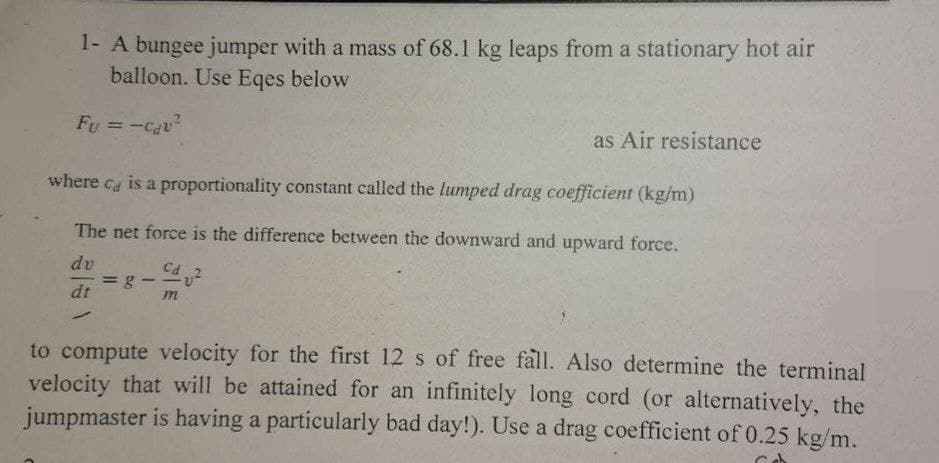1- A bungee jumper with a mass of 68.1 kg leaps from a stationary hot air balloon. Use Eqes below Fu = -cau² where ca is a proportionality constant called the lumped drag coefficient (kg/m) The net force is the difference between the downward and upward force. dv dt Cd = g -v² - as Air resistance m to compute velocity for the first 12 s of free fall. Also determine the terminal velocity that will be attained for an infinitely long cord (or alternatively, the jumpmaster is having a particularly bad day!). Use a drag coefficient of 0.25 kg/m.
1- A bungee jumper with a mass of 68.1 kg leaps from a stationary hot air balloon. Use Eqes below Fu = -cau² where ca is a proportionality constant called the lumped drag coefficient (kg/m) The net force is the difference between the downward and upward force. dv dt Cd = g -v² - as Air resistance m to compute velocity for the first 12 s of free fall. Also determine the terminal velocity that will be attained for an infinitely long cord (or alternatively, the jumpmaster is having a particularly bad day!). Use a drag coefficient of 0.25 kg/m.
Introduction to Chemical Engineering Thermodynamics
8th Edition
ISBN:9781259696527
Author:J.M. Smith Termodinamica en ingenieria quimica, Hendrick C Van Ness, Michael Abbott, Mark Swihart
Publisher:J.M. Smith Termodinamica en ingenieria quimica, Hendrick C Van Ness, Michael Abbott, Mark Swihart
Chapter1: Introduction
Section: Chapter Questions
Problem 1.1P
Related questions
Question

Transcribed Image Text:1- A bungee jumper with a mass of 68.1 kg leaps from a stationary hot air
balloon. Use Eqes below
Fu = -cau²
where ca is a proportionality constant called the lumped drag coefficient (kg/m)
The net force is the difference between the downward and upward force.
dv
dt
✓
-
Cd
as Air resistance
m
to compute velocity for the first 12 s of free fall. Also determine the terminal
velocity that will be attained for an infinitely long cord (or alternatively, the
jumpmaster is having a particularly bad day!). Use a drag coefficient of 0.25 kg/m.
Expert Solution
This question has been solved!
Explore an expertly crafted, step-by-step solution for a thorough understanding of key concepts.
This is a popular solution!
Trending now
This is a popular solution!
Step by step
Solved in 3 steps with 2 images

Recommended textbooks for you

Introduction to Chemical Engineering Thermodynami…
Chemical Engineering
ISBN:
9781259696527
Author:
J.M. Smith Termodinamica en ingenieria quimica, Hendrick C Van Ness, Michael Abbott, Mark Swihart
Publisher:
McGraw-Hill Education

Elementary Principles of Chemical Processes, Bind…
Chemical Engineering
ISBN:
9781118431221
Author:
Richard M. Felder, Ronald W. Rousseau, Lisa G. Bullard
Publisher:
WILEY

Elements of Chemical Reaction Engineering (5th Ed…
Chemical Engineering
ISBN:
9780133887518
Author:
H. Scott Fogler
Publisher:
Prentice Hall

Introduction to Chemical Engineering Thermodynami…
Chemical Engineering
ISBN:
9781259696527
Author:
J.M. Smith Termodinamica en ingenieria quimica, Hendrick C Van Ness, Michael Abbott, Mark Swihart
Publisher:
McGraw-Hill Education

Elementary Principles of Chemical Processes, Bind…
Chemical Engineering
ISBN:
9781118431221
Author:
Richard M. Felder, Ronald W. Rousseau, Lisa G. Bullard
Publisher:
WILEY

Elements of Chemical Reaction Engineering (5th Ed…
Chemical Engineering
ISBN:
9780133887518
Author:
H. Scott Fogler
Publisher:
Prentice Hall


Industrial Plastics: Theory and Applications
Chemical Engineering
ISBN:
9781285061238
Author:
Lokensgard, Erik
Publisher:
Delmar Cengage Learning

Unit Operations of Chemical Engineering
Chemical Engineering
ISBN:
9780072848236
Author:
Warren McCabe, Julian C. Smith, Peter Harriott
Publisher:
McGraw-Hill Companies, The